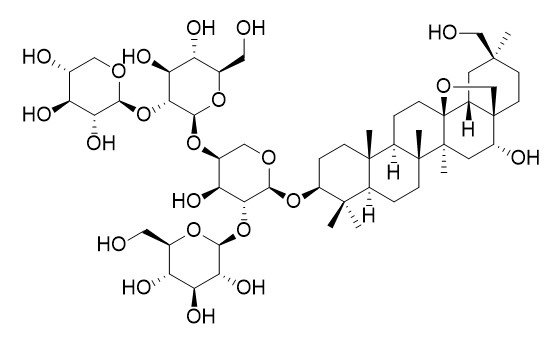Ardisicrenoside B
Reference standards.
Inquire / Order:
manager@chemfaces.com
Technical Inquiries:
service@chemfaces.com
Tel:
+86-27-84237783
Fax:
+86-27-84254680
Address:
1 Building, No. 83, CheCheng Rd., Wuhan Economic and Technological Development Zone, Wuhan, Hubei 430056, PRC
Providing storage is as stated on the product vial and the vial is kept tightly sealed, the product can be stored for up to
24 months(2-8C).
Wherever possible, you should prepare and use solutions on the same day. However, if you need to make up stock solutions in advance, we recommend that you store the solution as aliquots in tightly sealed vials at -20C. Generally, these will be useable for up to two weeks. Before use, and prior to opening the vial we recommend that you allow your product to equilibrate to room temperature for at least 1 hour.
Need more advice on solubility, usage and handling? Please email to: service@chemfaces.com
The packaging of the product may have turned upside down during transportation, resulting in the natural compounds adhering to the neck or cap of the vial. take the vial out of its packaging and gently shake to let the compounds fall to the bottom of the vial. for liquid products, centrifuge at 200-500 RPM to gather the liquid at the bottom of the vial. try to avoid loss or contamination during handling.
Appl. Sci. 2021, 11(22),10569
J Liq Chromatogr R T2018, 41(12):761-769
Journal of Cluster Science2024, 35:635-656.
Int J Mol Sci.2015, 16(8):18396-411
World J Mens Health.2019, 10.5534
Kaohsiung J Med Sci.2024, 40(3):280-290.
Progress In Microbes & Molecular Biology2025, 8,1:a0000470.
J Ethnopharmacol.2021, 267:113615.
Acta Agriculturae Scandinavica2015, 381-383
Antioxidants (Basel).2023, 12(7):1324.
Related and Featured Products
Planta Med. 2011 Oct;77(15):1742-8.
Quantitative determination of triperpene saponins and alkenated-phenolics from Labisia pumila using an LC-UV/ELSD method and confirmation by LC-ESI-TOF.[Pubmed:
21590653 ]
This study describes the first analytical method for the determination of four triterpene saponins (Ardisicrenoside B, ardisiacrispin A, 3- O- α- L-rhamnopyranosyl-(1 → 2)-β-D-glucopyranosyl-(1 → 4)-α-L-arabinopynanosyl cyclamiretin A and ardisimamilloside H) and three alkenated-phenolics (irisresorcinol, belamcandol B, and demethylbelamcandaquinone B) from the leaves, leaves/stems, and roots of LABISIA PUMILA using an HPLC-UV-ELSD method.
METHODS AND RESULTS:
The separation was achieved using a reversed-phase (C-18) column, PDA and ELS detection, and a water/acetonitrile gradient as the mobile phase. The major triterpenoid (ardisiacrispin A) and irisresorcinol compounds were detected at a concentration as low as 10.0 and 0.2 μg/mL, respectively. Analysis of various samples showed considerable variation of 0.11-2.46 % for the major triterpenoid compound, ardisiacrispin A. LC-mass spectrometry method coupled with electrospray ionization (ESI) is described for the identification of compounds in plant samples.
CONCLUSIONS:
This method involved the use of the [M + Na]+ and [M + NH₄]+ ions for compounds 1-4 in the positive ion mode with extractive ion chromatogram (EIC).
J Asian Nat Prod Res. 2008 Mar-Apr;10(3-4):291-6.
Triterpene saponins from Lysimachia christinae.[Pubmed:
18335347 ]
METHODS AND RESULTS:
Seven triterpene saponins were isolated from Lysimachia christinae and identified as lysichriside A (1), lysichriside B (2), primulanin (3), lysikokianoside 1 (4), anagallisin C (5), ardisiacrispin A (6), and Ardisicrenoside B (7). Compounds 1 and 2 are new triterpene saponins, compounds 3, 5, and 7 were isolated from this genus, and compounds 4 and 6 were isolated from this species for the first time.
CONCLUSIONS:
Their structures were elucidated by means of 1D and 2D NMR experiments.



